Everyone knows a big dog when they see one. Many people have owned or known big dogs, from the gentle giant of their harlequin Great Dane to their neighbor’s hairy, sweet-tempered, bear-sized Newfoundland. Many big dog breeds were originally developed to be working dogs. This means they do everything from hunting jaguars in South America to police and rescue work to guarding homes and people. Many of these breeds are ancient. Though a person can just look at a dog and see how big it is, the official definition of a big dog is one that weighs at least 50 pounds and stands at least 24 inches in height at the shoulder. Some breeders even stipulate that the dog weighs at least 70 pounds. Read on for more information about the different types of big dogs. These big dog breeds are listed from “smallest” to biggest.
#8. St. Bernard
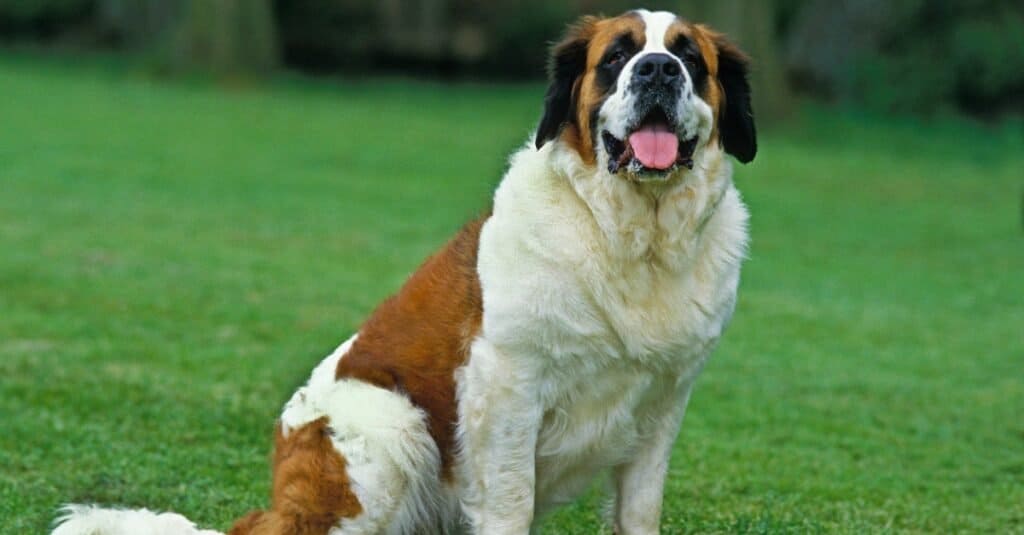
©iStock.com/slowmotiongli
Gentle, slow, and good with children, the Saint Bernard originated in Switzerland about 1000 years ago, a descendent of a mastiff ancient Romans brought to the Swiss Alps 1000 years before that. It is famously bred to rescue people who’ve gotten lost in the mountains by the monks of the St. Bernard de Menthon hospice.
The St. Bernard is a massive dog, with a huge head, extremely muscular neck, and a deep chest. Its coat can be long-haired or smooth. It stands 24 to 28 inches in height and weighs between 110 and 200 pounds. Very intelligent but biddable, the St. Bernard can be trained to be a good watchdog but can intimidate with its size alone. It can do well in an apartment if it’s exercised, but the dog needs a firm hand when it’s taken out for a walk. The St. Bernard famously drools after meals, and its coat sheds twice a year but is easy to care for. Like other big dog breeds, it doesn’t live long and is subject to health problems such as bloat, heart trouble, and hip dysplasia.
Go here to read more about the St. Bernard dog.
#7. Newfoundland
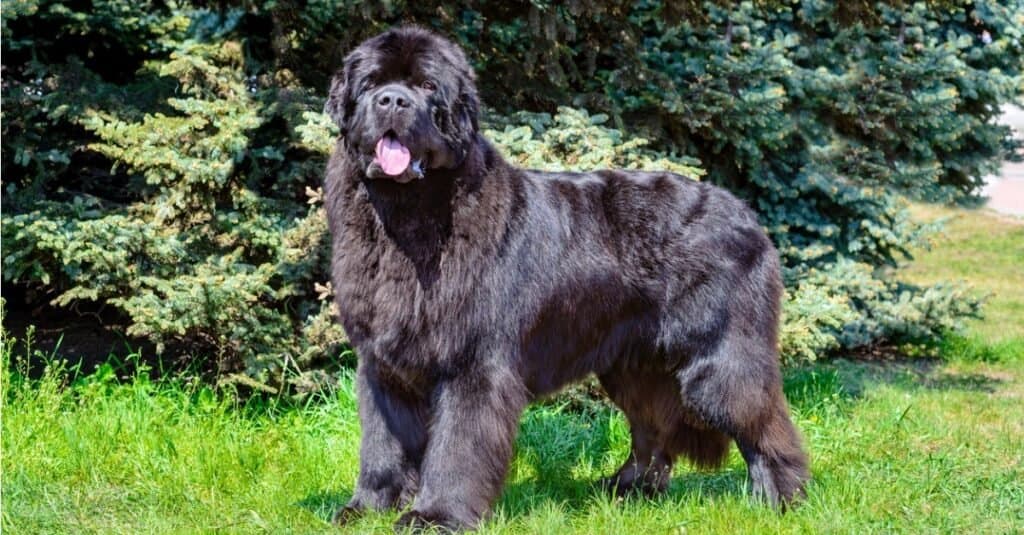
©iStock.com/volofin
You will be forgiven if you mistake a grown Newfoundland for a bear. This dog is not only huge, but its fluffy coat makes it look not only bigger than it already is but definitely ursine. Yet, the Newfoundland is a gentle giant. Developed in 18th century Canada to help fishermen haul in their nets, this dog’s trademark fluffy coat is dense, coarse and water-resistant.
The Newfoundland stands between 26 and 28 inches high at the shoulder and weighs between 110 and 150 pounds. Its coat comes in dark brown or black, and it has a short muzzle, a huge skull set on a powerful neck, small ears, and powerful hindquarters and feet. The feet, as is the case with many dogs that do water work, are webbed. There’s also some feathering on the legs and the tail.
Because this big dog is subject to hip dysplasia, it is important that it not be allowed to get too fat. The owners should still be able to feel the dog’s ribs beneath its fur. The Newfoundland can live in an apartment if it gets exercise. However, a dog with such a hairy coat won’t do well in a hot environment.
For more information about the Newfoundland, read this.
#6. Neapolitan Mastiff

©iStock.com/Okikukai
Remember Fang, Hagrid’s dog in Harry Potter? He was played by a Neapolitan mastiff. This is a huge, solidly built dog with an enormous head and smashed-in face full of folds, dewlaps, and wrinkles. This gives the dog a melancholy look, but it is affectionate, docile, protective, and good with children. It does drool a great deal, and because of its huge head puppies are born by Caesarian section. Puppies are also born with blue eyes that darken over time.
The Neapolitan mastiff originated in Italy around 100 BC and was trained to guard and fight other dogs. The folds and dewlaps on its head probably made it hard for other dogs to get a grip on it. The dog’s other fighting attributes can be seen in its wide, flat skull, long body, short, heavily muscled neck, and deep chest. Its toes are arched, and its front feet are a little bigger than its hind feet. The coat is dense, short, hard, and glossy. If the tail isn’t docked, it curves over the dog’s back.
The dog stands between 26 and 29 inches high at the shoulder and weighs between 110 and 150 pounds. It doesn’t mind living in an apartment but needs lots of exercises. Health problems might include hip dysplasia. Despite its short coat, the dog should be protected from getting overheated. Unfortunately, the Neapolitan mastiff only lives for about 10 years.
To learn more about this dog, go here.
#5. Mastiff

©Volodymyr Burdiak/Shutterstock.com
Developed in Great Britain around 1000 BC, this massive dog was bred as a guardian and praised by no less a personage than Julius Caesar for its bravery. Every aspect of the dog is big, well-muscled, and powerful. It has a huge head, a deep chest, and flanks and legs that are strong and straight. The dog always has a black mask on its face, no matter the color of the rest of its coat. Its coat is short and lies close to the body and the ears are flat and start at the highest part on both sides of the skull. When it’s alerted by something, its forehead wrinkles, charmingly.
The mastiff stands 27.5 to 30 inches in height and weighs between 175 and 190 pounds. As many different types of big dogs, it can be happy in an apartment as long as it gets its exercise and its daily walk. The mastiff lives as long as 12 years but is subject to health problems such as bloat and hip dysplasia.
Read this to learn more about the mastiff.
#4. Leonberger
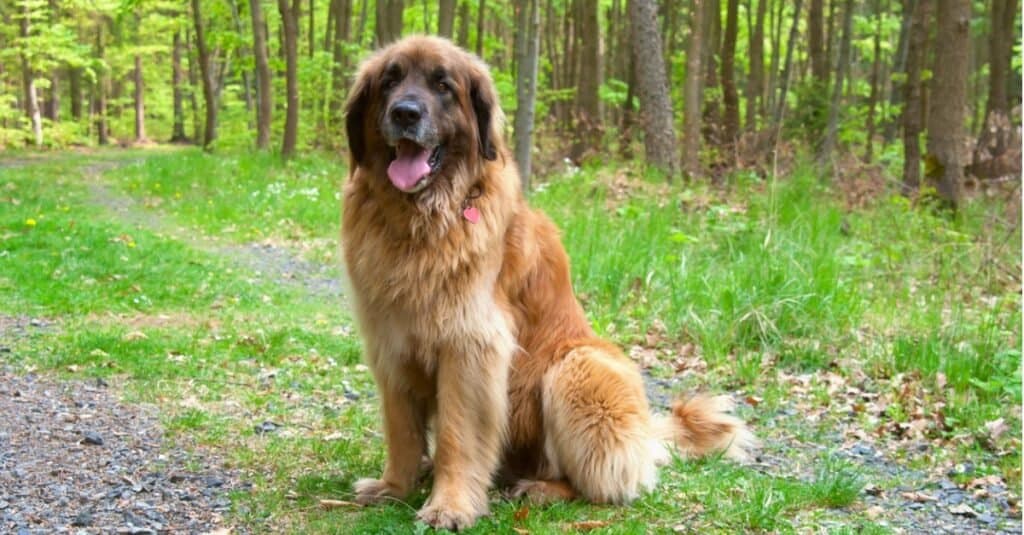
©Kaca Skokanova/Shutterstock.com
The reason for this dog’s existence is singular. Originating in Germany in 1846, the Leonberger was bred for no other reason than to resemble the dog on the crest of the town of Leonberg. Descended partially from Newfoundland, this big, friendly dog stands 26 to 31.5 inches high at the shoulder and weighs between 75 and 110 pounds. Like the Newfoundland, it loves water and has webbed toes, but the dog always has a black mask and its coat is always shades of brown, reddish-brown, or yellow if it is to be shown. The Leonberger has medium to long hair on its tail and around its neck and shoulders and feathering on its legs. The hairs can be tipped with black.
This dog doesn’t thrive in an apartment, and its fluffy coat makes it unsuitable for a warm climate. It needs some exercise, including a swim now and then. Like other big dogs, the Leonberger is prone to hip and other bone problems and needs regular grooming. Its lifespan can be a little longer than other giant dogs as it can live as long as 15 years.
Read here for more information about the Leonberger.
#3. Komondor
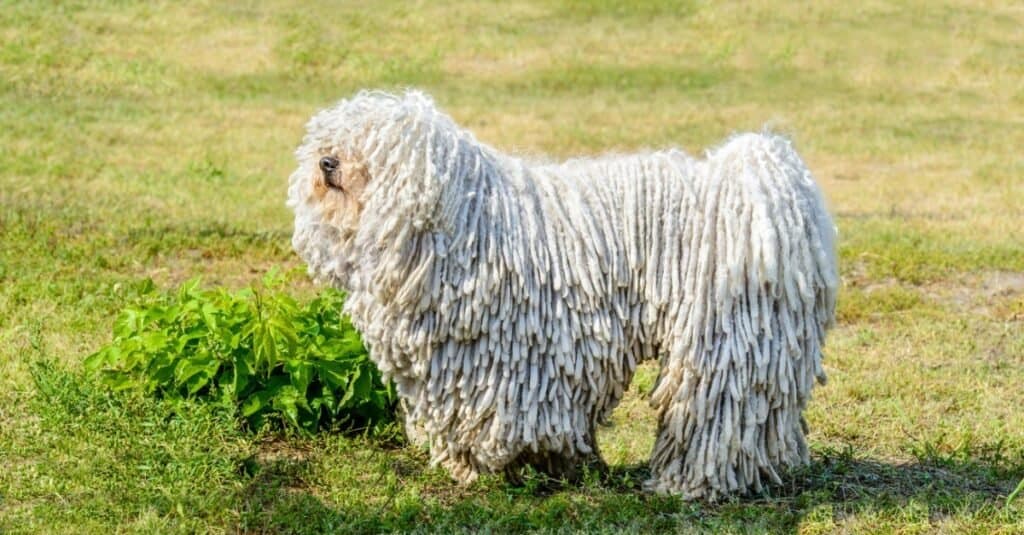
©iStock.com/volofin
The long hair of this big dog grows naturally into dreadlocks or cords. The hairs grow so long that they cover the animal’s feet. The komondor originated in Hungary in the 9th century and was bred to guard sheep, which it sort of resembles.
Though much of the dog is hidden under its long hair, the komondor has a large head with a slight arch to it, a short muzzle, and a large, black nose. The ears are medium-sized and the eyes, also hidden behind the curtain of long hair, are brown and almond-shaped. The tail falls to the hocks, neither of which can be seen in a grown dog. The unique coat takes about two years to form and five years until it reaches down to the ground.
A komondor stands about 26 to 32 inches in height and weighs between 80 and 135 pounds. It does best out in the country and is a perfect outdoor dog. As for grooming, the dog’s hair should never be combed or, the locks should be trimmed and divided. One good thing about the komondor’s coat is that it doesn’t shed.
#2. Great Dane
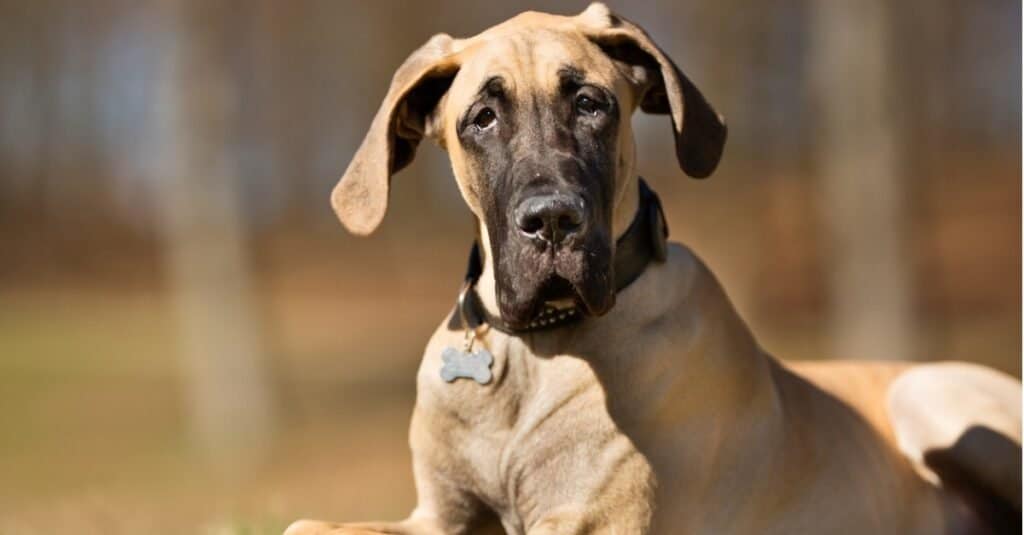
©iStock.com/Bigandt_Photography
This famously huge and sweet-natured dog originated not in Denmark but in Germany. It is one of the oldest big dog breeds and first appeared as long ago as 2000 BC. The Great Dane makes an excellent addition to a family with young children. Since it’s a laid-back sort of dog, it can do well in an apartment as long as it gets plenty of exercise.
Despite its gargantuan size, the Great Dane is a graceful dog, with a deep chest, a wide, ridged nose, a long back, a long, tapering tail, a sleek, dense coat, and round, somewhat melancholy eyes. Male Great Danes stand about 30 to 34 inches high at the shoulder and weigh between 120 and 200 pounds, while females are shorter and lighter. The bigger the dog is the more it is valued, but the dog’s size comes with some penalties. Like most large dogs, the Great Dane doesn’t live very long, and some don’t even make it to 10 years. It’s also subject to hip dysplasia, cancers, and heart disease.
Go here to learn more about the Great Dane.
#1. Irish Wolfhound

©iStock.com/Ashva
Of all the different types of big dogs, the Irish wolfhound is not just big, it is tall. When it stands on its hind legs it can be 7 feet tall. Another ancient breed, this dog originated in Ireland around 100 BC to, as its name says, hunt wolves. Despite this, it too is a gentle giant of a dog and loves everyone. The only thing that makes the Irish wolfhound a good watchdog is its sheer size.
The Irish wolfhound stands between 28 and 35 inches high at the shoulder and weighs between 90 and 120 pounds. Its long back, neck, and legs are what make it tall. The Irish wolfhound has a rough, somewhat messy coat, arched toes, a tightly drawn-in belly that gives the body an elegant silhouette, and a strong neck and shoulders. It has small ears, a wiry beard, and long, hairy eyebrows.
Like other big dog breeds, the Irish wolfhound is vulnerable to hip dysplasia, and puppies should not be taken on long walks until they’re grown. Unlike the Newfoundland and Great Dane, it needs a yard to run around in. Sadly, its lifespan is even shorter than that of the Great Dane. An Irish wolfhound only lives six to eight years.
For more information about the Irish wolfhound, read this.
Up Next…
- Types of Herding Dogs: They’re intelligent, loyal and specialize in keeping cattle, reindeer, and sheep, in order. Read about these special breeds and the qualities they have that set them apart from the rest.
- Types of Working Dogs: They sniff out explosives, guard property, and herd cattle, in addition to so much more. Read about these hardworking dogs and the best breeds for specific roles.
- Types of Husky Dogs: They’re intelligent, energetic, and strong willed. Read about these canines which are one of the most popular breeds for pet lovers everywhere.
The photo featured at the top of this post is © iStock.com/AlexanderKondakov
Ready to discover the top 10 cutest dog breeds in the entire world?
How about the fastest dogs, the largest dogs and those that are -- quite frankly -- just the kindest dogs on the planet? Each day, AZ Animals sends out lists just like this to our thousands of email subscribers. And the best part? It's FREE. Join today by entering your email below.
Thank you for reading! Have some feedback for us? Contact the AZ Animals editorial team.







